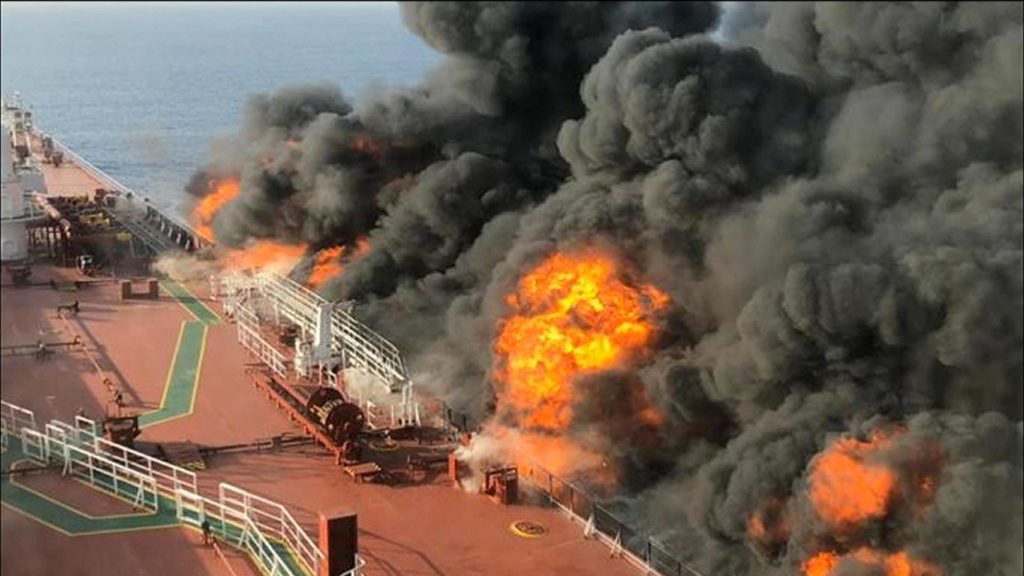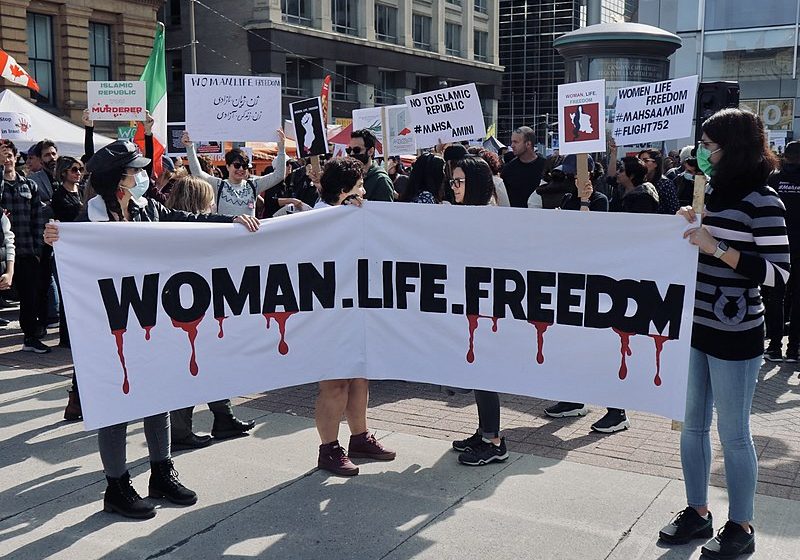Australia/Israel Review
Engulfed by crisis
Jun 26, 2019 | Farzin Nadimi

On June 13, two tankers originating from Saudi Arabia and the United Arab Emirates (UAE) were hit by sabotage attacks, just one month after four tankers anchored off the UAE coast were targeted by what international investigators say was almost certainly a state actor. This time, the attacks were carried out in broad daylight and while the vessels were exiting the Strait of Hormuz at full speed. If the already copious evidence of Iranian involvement proves true, what does the incident say about Teheran’s near-term intentions in the area?
THE EVIDENCE SO FAR
On June 13, the Norwegian-owned, Marshall Islands-flagged tanker Front Altair was badly damaged by an attack that left a huge column of smoke rising from its hull. With a capacity of 110,000 deadweight tonnes, the medium-size Aframax crude carrier was sailing from Abu Dhabi’s al-Ruwais refinery to Taiwan with a 75,000-tonne cargo of naphtha, a slow-burning petroleum product used as feedstock at refineries.
Photos and aerial footage released by Iranian authorities appeared to show a point of impact in the middle of the ship, but also significant fire damage to the accommodation island and engine room, suggesting the tanker was subjected to multiple attacks that will likely render it a total loss (though it appears to have maintained its structural integrity for the time being).
About an hour later, a second tanker was attacked about 70 nautical miles from Fujairah in the UAE and fourteen nautical miles off Iran’s coast just south of Jask, not far from the first attack. The Japanese-owned, Panamanian-flagged Kokuka Courageous, a smaller 27,000-deadweight-ton vessel, was sailing from the Saudi port of Jubail to Singapore with a cargo of methanol. A waterline breach in its starboard hull caused a fire in the engine room; the vessel is apparently taking in water, though the cargo is reportedly intact.
The two attacks occurred less than 50 kilometres from each other and just outside Iran’s territorial waters, under the watchful eyes of Iranian radar and monitoring stations. Although the attacks appeared to come from the west side of the ships, their location was suspiciously close to an important Iranian naval base at Jask.
Initial reports suggested the tankers may have been hit with torpedoes or surface attacks, but credible eyewitness reports indicate that explosives were attached to their hulls using speedboats (whose wakes could have been mistaken for torpedoes to the untrained eye). The crew of the Kokuka Courageous abandoned ship after they discovered an unexploded device still clinging to the hull; surveillance footage released by the US Navy showed a speedboat manned by Islamic Revolutionary Guard Corps Navy personnel frantically trying to remove the device. Teheran has yet to disclose the discovery of such an important piece of evidence.
The Altair crew was rescued by the regular Iranian navy and taken to Jask and then Bandar Abbas, while sailors from Kokuka Courageous were eventually taken in by the American guided-missile destroyer USS Bainbridge. It is not known whether the footage of the explosive’s removal was taken before or after the sailors were rescued.
At a subsequent news conference, the Japanese owner of Kokuka Courageous stated that the crew had detected high-speed flying objects approaching the ship right before the attack, suggesting that at least some of the explosions may have been caused by explosive-laden suicide drones. Iran has a military airstrip about 50 kilometres northeast of the attack location that has been frequently used to operate drones. As for the planted explosives, they seem to have been timed to detonate just after the tankers cleared the Strait of Hormuz, but still in proximity to Iranian waters.
These facts, coupled with the amount of coordination required to carry out such operations, leave little doubt that Iran is once again the culprit.
As happened during Persian Gulf naval confrontations with the United States in the 1980s, Iranian leaders are not expected to take responsibility for the actions of their forces in local waters. In the past, they have credited attacks to “the hand of God” or blamed Western countries for mining incidents, only to take credit for them later (e.g., off the coast of Fujairah in 1987). It would come as little surprise to hear them make similar claims today – Iran’s UN mission has already blamed the United States for the explosions, while a maritime agency official claimed that “technical problems” most likely caused the fires on both ships.
IRAN’S LEVERAGE IN THE GAME OF PRESSURE
The increasing momentum of the US “maximum pressure” policy has prompted Iran to react more aggressively of late.
In a May 29 speech, Supreme Leader Ali Khamenei declared that the “only way” to gain strategic leverage over America is to beat Washington at its own game of pressure – not through negotiations, which Khamenei described as the preferred US tactic, but rather through “our own tools of leverage,” including “military tools”. He promised to use more such tools if the regime’s recent threat to resume certain nuclear activities did not yield the desired result of easing sanctions and helping Iran’s economy. Given such rhetoric, it is difficult to view the latest attacks as anything but the regime doing just what Khamenei said it would.
The tanker incidents could also be seen as an attempt to challenge America’s measured deterrence and its position as a superpower.
Indeed, if the attacks go unanswered, they could undermine Washington’s credibility among its regional allies. At the same time, Teheran presumably hopes to manage escalation, maintain the element of surprise, and preserve plausible deniability. The latter goal may explain why Iran rushed to rescue some of the stranded sailors – who might also serve as human shields if the United States or other actors launch retaliatory action.
The attacks also coincided with Japanese Prime Minister Shinzo Abe’s much-anticipated visit to Tehran, raising speculation that Iran targeted a Japanese ship to send a bold and clear message of dissatisfaction with Tokyo’s role in upholding US sanctions. Just hours before the attacks, Khamenei publicly declared that US President Trump was not worth exchanging messages with – a seemingly direct slap at Prime Minister Abe, who was rumoured to be carrying a message from the White House for Iran. This tactic would be in keeping with the IRGC’s penchant for undermining and humiliating Iran’s own Foreign Ministry whenever a domestic scapegoat is needed to absorb blame.
The nature of the tankers’ cargo sheds further light on how far Teheran may be willing to go, assuming it is responsible for the attacks.
The Kokuka Courageous is a type 2 chemical tanker clearly marked to carry products that pose severe environmental and safety hazards. A premeditated attack against such a vessel shows complete disregard for the significant environmental and human damage that spilling such products could cause. One can therefore expect future attacks to raise the risk of oil slicks and other such problems.
Moreover, Al-Ruwais refinery, the origin of one of the tankers, is considered a major regional competitor to Iran’s petrochemical industry – and a major beneficiary if new sanctions on Iran’s petrochemical exports wind up having a severe impact on the regime’s bottom line. In that sense, the attacks could have been designed as direct retaliation against those sanctions.
The broader warning seems clear: the region should not expect calm at a time when Iran’s oil export revenues are falling to record lows and its petrochemical revenues are threatening to do the same. Rather, the regime’s disruptive measures may gradually expand in size, geography, and complexity, perhaps even extending to military targets.
Washington should therefore send specific, unambiguous messages about how it will respond to each level of Iranian escalation, both to deter the regime and shape the international response if military action becomes necessary.
Finally, if by chance Iran is not definitively found to be responsible for the tanker attacks, the incident should still spur the international community to increase its presence and protective activity in waters normally patrolled by Iran, even at the risk of increasing tensions with the IRGC.
The United States should consider sending more meaningful reinforcements to the area at least temporarily, including another aircraft carrier such as the USS Ronald Reagan.
Farzin Nadimi is an associate fellow with the Washington Institute for Near East Policy specialising in the security and defence affairs of Iran and the Gulf region. © Washington Institute, reprinted by permission, all rights reserved.
Tags: Gulf states, Iran, United States






